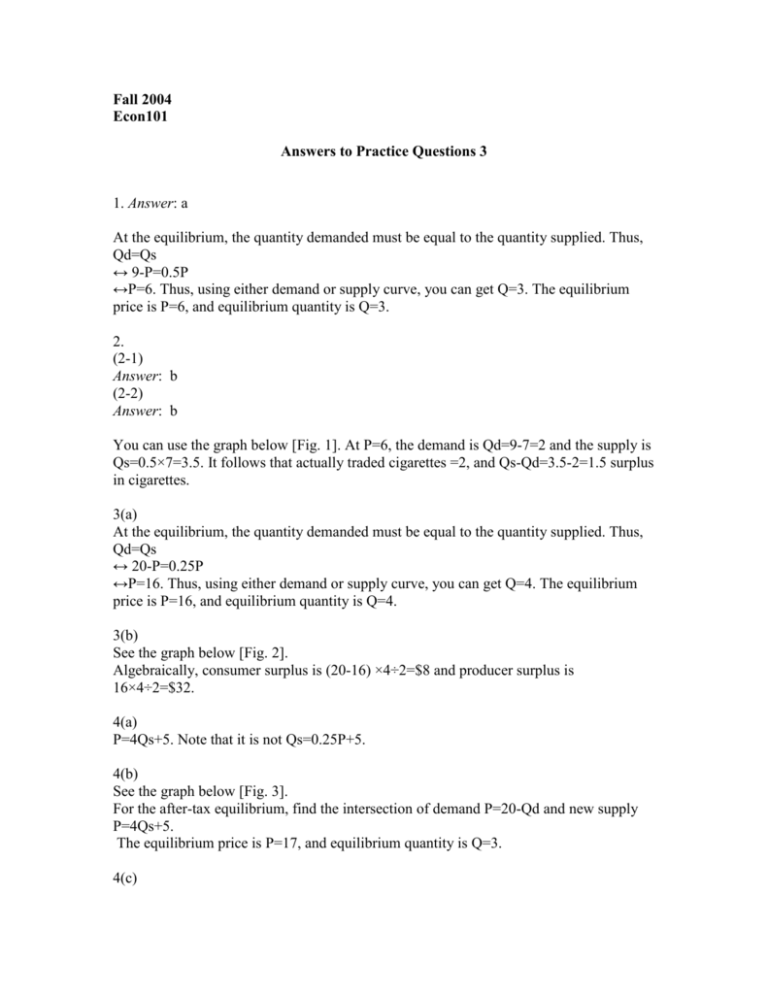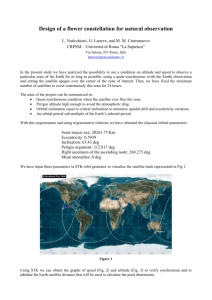Answers to Practice Questions 3
advertisement

Fall 2004 Econ101 Answers to Practice Questions 3 1. Answer: a At the equilibrium, the quantity demanded must be equal to the quantity supplied. Thus, Qd=Qs ↔ 9-P=0.5P ↔P=6. Thus, using either demand or supply curve, you can get Q=3. The equilibrium price is P=6, and equilibrium quantity is Q=3. 2. (2-1) Answer: b (2-2) Answer: b You can use the graph below [Fig. 1]. At P=6, the demand is Qd=9-7=2 and the supply is Qs=0.5×7=3.5. It follows that actually traded cigarettes =2, and Qs-Qd=3.5-2=1.5 surplus in cigarettes. 3(a) At the equilibrium, the quantity demanded must be equal to the quantity supplied. Thus, Qd=Qs ↔ 20-P=0.25P ↔P=16. Thus, using either demand or supply curve, you can get Q=4. The equilibrium price is P=16, and equilibrium quantity is Q=4. 3(b) See the graph below [Fig. 2]. Algebraically, consumer surplus is (20-16) ×4÷2=$8 and producer surplus is 16×4÷2=$32. 4(a) P=4Qs+5. Note that it is not Qs=0.25P+5. 4(b) See the graph below [Fig. 3]. For the after-tax equilibrium, find the intersection of demand P=20-Qd and new supply P=4Qs+5. The equilibrium price is P=17, and equilibrium quantity is Q=3. 4(c) Since $5 goes to the government, the net price received by wine producers is $17-$5=$12. 4(d) See the graph below [Fig. 4]. Consumer surplus after the tax is (20-17) ×3÷2=$4.5. 4(e) See the graph below [Fig. 4]. Producer surplus after the tax is 12×3÷2=$18. 4(f) See the graph below [Fig. 5]. The tax paid by consumers (consumer tax incidence) is (17-16) ×3=3. 4(g) See the graph below [Fig. 5]. The tax paid by producers (producer tax incidence) is (16-12) ×3=$12. 4(h) See the graph below [Fig. 6]. Since the tax revenue=consumer tax incidence + producer tax incidence, the tax revenue is $15. 4(i) See the graph below [Fig. 7]. The dead weight loss is (17-12) ×(4-3)÷2=$2.5. 4 (j) See the graph below [Fig. 8]. The larger rectangular in Fig. 8 corresponds to the new consumer tax incidence; the smaller rectangular in Fig. 8 corresponds to the original consumer tax incidence. Hence, the new share of consumer tax incidence is bigger than the one you found in 4(f). 4 (k) See the graph below [Fig. 9]. The smaller rectangular in Fig. 9 corresponds to the new consumer tax incidence; the larger rectangular in Fig. 9 corresponds to the original consumer tax incidence. From Fig.9, the new share of consumer tax incidence is smaller than the one you found in 4(f).








